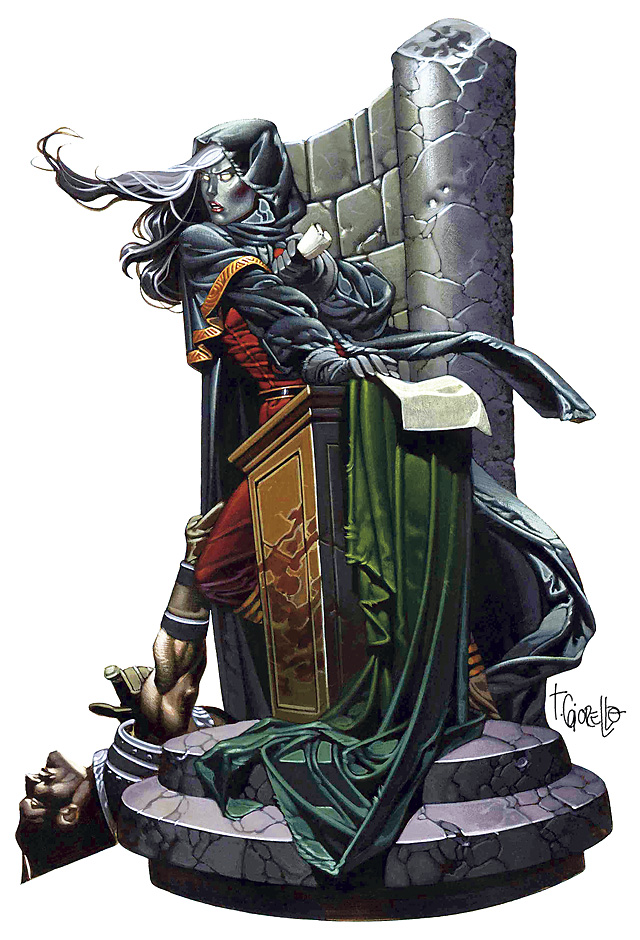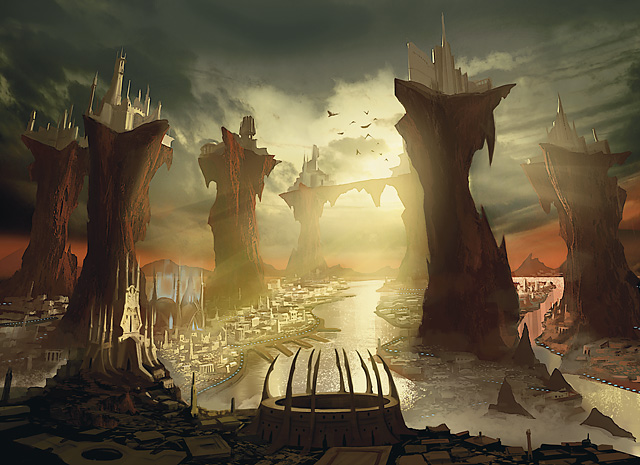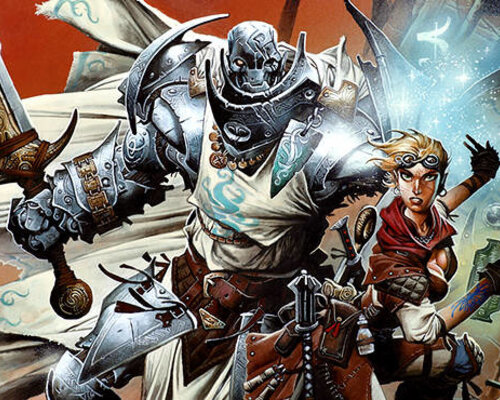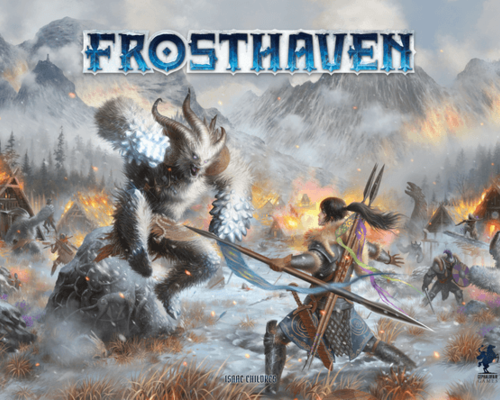Eberron: Rising from the Last War released this week, the first proper hardcover release in the setting since 4th edition. The Dungeons & Dragons player base has exploded since then, with 5th edition introducing a whole new generation to the game. Most will have started their adventures in Faerûn, the world of the Forgotten Realms, which has acted as the de facto “default” setting for 5th edition since its inception. Since then, with only a few limited releases centered around other settings (looking at you, Guildmaster’s Guide to Ravnica) there hasn’t been a lot of opportunity for players to really branch out into the other settings that D&D has to offer, at least not with the full design support of Wizards of the Coast (no, unearthed arcana doesn’t count). So I thought I’d put together a short list of what makes Eberron unique among the D&D settings, and why you should join everyone who’s already taken the plunge and start your very own campaign in this awesome, dungeonpunk world!
1. The Mundane Arcane

In Eberron, magic is everywhere… I know, I know, that may not seem like much when we're talking about D&D. Toss a rock in any direction in the Forgotten Realms, and chances are you’ll hit a hedge wizard, and adventurers are constantly stubbing their toes on the +1 weapons that litter the ground. Still, in the fiction of Faerûn there is still a marked difference between the haves and have nots where magic is concerned. You can travel the countryside reasonably sure that the dirt farmers you are running errands for at low-level won’t turn out to be secret eldritch masters. Magic, while commonly encountered by adventurers, is still treated with a degree of reverence and awe by the common person.
Not so in Eberron. The world of Eberron belongs to a subgenre of fantasy called “dungeonpunk”. Dungeonpunk, much like its more famous sibling steampunk, creates a twist on the fantasy genre by positing a world in which history and technological advancement followed a line of development different from our own. In Eberron, the tools, weapons and vehicles of the world are on an analogous technological level as those of our world circa 1920 - except these inventions are powered by magic, rather than steam, electricity, and fossil fuels.
This means that the people of Eberron have developed a very different relationship with the arcane than those of other settings - and so have the player characters. Magic loses a little of its *ahem* magic, when you encounter it everyday in the most mundane circumstances. Lightning elementals are cool, until you miss your train to work because the elemental powering it is getting uppity (anyone who has had to wait for LRT delays knows what this feels like). Yeah, when you find a new wand in Faerûn it makes your week, but what if you brought it back to town and saw that there were a dozen more of them on sale at Wands-R-Us? Ever been stuck in a skyboat traffic jam with a chatty goblin cab driver? THE WOOOOORST!
This isn’t to say that there aren’t wilder places in the world where these amenities are rarer, but anywhere there is proper civilization in Eberron there is magic in abundance. Wrapping their heads around this new thaumaturgical reality is the biggest step that new players have to take, but once they do it opens up whole new avenues to roleplaying.
2. Intrigue and Subterfuge

Eberron, more than maybe any other D&D setting, is a world built for political campaigns. Or detective campaigns, or criminal underworld campaigns. Any campaign in which intrigue is the primary driver of the action.
The main continent of Khorvaire is lousy with nations, guilds, dragonmark houses, criminal organizations, and other factions, all looking to stake their claim in a crowded political landscape. Players with a roleplay and narrative heavy playstyle will feel right at home navigating the complex relationships between the powers of the continent. With tensions between the major nations of Khorvaire still simmering after the Last War, the consequences of a player character’s indelicacy may have farther reaching implications than you’d think.
This doesn’t mean there still aren’t places in the world where you can have a more traditional adventuring experience in a wild, fantasy frontier (looking at you Xen’drik), but Eberron is one of the few settings that feels like it was truly designed with space for noncombat (or at least lesser-combat) characters. So go ahead, and run that hardboiled detective story in Sharn (D&D’s answer to the New York City of the 70s and 80s). Assemble a team of diplomats to navigate the tensions between the formerly warring nations. Establish your own crime syndicate, and reap the benefits of the dark side of the alchemical trade. Go nuts!
3. Agnostic Fantasy

Another unique thing about Eberron is that, unlike other D&D settings, the gods of the world, how should I put this… well, they may not be real. Oh, sure, divine spellcasters can still sling their spells, but unlike in Forgotten Realms, it’s highly unlikely that they’ll ever encounter definitive proof of their existence. You’ll never find, say, Arawai waiting for you on another plane. Most people do have a religion or belong to a specific church, and most believe that the gods are where divine magic originates - it’s just that no one’s definitively encountered them.
The religions of Eberron are varied and diverse: from the archetypically “good” deities of the Sovereign Host, the chthonic worshippers of the Cult of the Dragon Below, to the immortal elves of the Undying Court. All of these religions have well developed belief systems, many of which are in conflict with each other on a philosophical level. This can even happen with religions with the same moral alignment. Both the Path of Light and Path of Inspiration are “lawful neutral” religions, and yet their philosophies oppose one another.
This presents a unique roleplaying challenge for divine magic users such as Clerics and Paladins. It’s easy to have faith when you can literally commune with your god, but when the existence of that god is uncertain? All of a sudden believing becomes a lot harder. This is a perfect way to introduce drama into the arc of a religious character.
4. Wounds of the Last War

Eberron is a wounded world. Having just gone through its largest conflict in recent history, the continent of Khorvaire is licking its wounds. The Last War, as it is called, was a continent spanning war between the five nations of Khorvaire, a magical version of our own World War I. (Even the name, the Last War invokes the phrase “the war to end all wars”). The war lasted a century, and as the year progressed, so did the magic and weapons used for killing. It is this war that gave Eberron the Warforged, the cool magical robots that can be seen in much of the promotional art for the setting. The war would probably have probably gone on forever if not for an event so cataclysmic that it shocked the warring nations into peace. The Day of Mourning
No one in-universe knows what caused the Day of Mourning (and Wizards of the Coast supposedly has no official answer to its cause either). All of a sudden, a grey mist began spreading throughout the nation of Cyre, one of the chief belligerents of the conflict. Those engulfed by the mist on the first day died, strange magical phenomenon suffused the land, and the remaining inhabitants of Cyre had to flee en masse, throwing themselves at the mercy of their former enemies. No life grows in Cyre, and the bodies of those killed by the mist remain, perfectly preserved in the mist that reaches to the borders of the nation.
This is the world that the players enter into, a world suffering the collective trauma after coming out of a long and deadly conflict. It is a world of veterans, refugees, and victims. Player characters may decide to be any of these, working the challenge of moving on into their character arcs. Is your character a refugee of Cyre, trying to find a new homeland for their people? Or a veteran of the war, who would rather drink away their trauma than face it. Or maybe a warforged, created for war, but now without one to fight. What is your place in this new world? As the subtitle of the setting book, Rising from the Last War, suggests, the biggest challenge for the denizens of Eberron is answering the question: what comes next?
Just as it takes inspiration from the moral quagmire that was the First World War, Eberron itself is a setting that greatly challenges the concept of alignment, which is usually so integral to D&D. There were no truly “good” or “evil” sides in the war, just a collection of nations with their own goals and a willingness to fight for them. Likewise, players are encouraged to approach the world in a way that allows for more moral nuance than that of other settings. Your characters hunt down a warforged serial killer, cutting a bloody swath through Sharn. Are they evil? They were made to kill after all, and with no one left to tell it who to fight, they only continued to serve their purpose in the only way they knew how.
All of this is the stuff which deep roleplaying is made of. Players will have to face situations in which there are perhaps no truly good outcomes and, more than that, they will have to live with the decisions they make.
So, does Eberron sound like your cup of tea? Then pick up a copy and try it for yourself!






